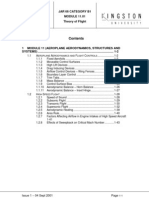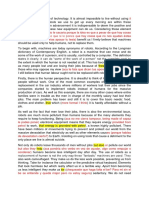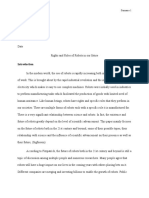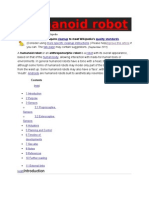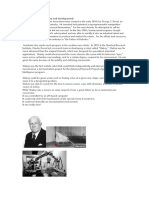0 ratings0% found this document useful (0 votes)
91 viewsFuture of Robotics in India
Future of Robotics in India
Uploaded by
rashmiRobots and machines are replacing some human functions and jobs. In areas like transporting goods in a factory, robots can work faster and for longer hours than humans. However, humans still have advantages over robots in fields requiring intelligence and adaptability, such as healthcare. While technology is making work easier, it is also decreasing the need for human labor and causing job losses. The future impact of robotics and AI on human existence is unclear but some experts warn that advanced artificial intelligence could threaten humanity.
Copyright:
© All Rights Reserved
Available Formats
Download as DOCX, PDF, TXT or read online from Scribd
Future of Robotics in India
Future of Robotics in India
Uploaded by
rashmi0 ratings0% found this document useful (0 votes)
91 views3 pagesRobots and machines are replacing some human functions and jobs. In areas like transporting goods in a factory, robots can work faster and for longer hours than humans. However, humans still have advantages over robots in fields requiring intelligence and adaptability, such as healthcare. While technology is making work easier, it is also decreasing the need for human labor and causing job losses. The future impact of robotics and AI on human existence is unclear but some experts warn that advanced artificial intelligence could threaten humanity.
Original Description:
it is best to read
Copyright
© © All Rights Reserved
Available Formats
DOCX, PDF, TXT or read online from Scribd
Share this document
Did you find this document useful?
Is this content inappropriate?
Robots and machines are replacing some human functions and jobs. In areas like transporting goods in a factory, robots can work faster and for longer hours than humans. However, humans still have advantages over robots in fields requiring intelligence and adaptability, such as healthcare. While technology is making work easier, it is also decreasing the need for human labor and causing job losses. The future impact of robotics and AI on human existence is unclear but some experts warn that advanced artificial intelligence could threaten humanity.
Copyright:
© All Rights Reserved
Available Formats
Download as DOCX, PDF, TXT or read online from Scribd
Download as docx, pdf, or txt
0 ratings0% found this document useful (0 votes)
91 views3 pagesFuture of Robotics in India
Future of Robotics in India
Uploaded by
rashmiRobots and machines are replacing some human functions and jobs. In areas like transporting goods in a factory, robots can work faster and for longer hours than humans. However, humans still have advantages over robots in fields requiring intelligence and adaptability, such as healthcare. While technology is making work easier, it is also decreasing the need for human labor and causing job losses. The future impact of robotics and AI on human existence is unclear but some experts warn that advanced artificial intelligence could threaten humanity.
Copyright:
© All Rights Reserved
Available Formats
Download as DOCX, PDF, TXT or read online from Scribd
Download as docx, pdf, or txt
You are on page 1of 3
Future of Robotics in India, will Robos can
threaten the human existence.
“ I fear the day that technology
will surpass our human interaction.
The world will have a generation of idiots.”
Almost every day, people of influence claim that machines will
soon threaten the existence of humanity. According to Stephen
Hawking, a well-known cosmologist, "The development of full
artificial intelligence could spell the end of the human race," and
Elon Musk, a renowned inventor and investor, insists, "I think
human extinction will probably occur, and technology will likely
play a part in this."
Part of the functions of human beings has been replaced by
machines and robots. In some cases, the functions of human
beings have been replaced completely. For example, in the transit
of goods in production from one section to another has been
replaced completely by the robots. These robots are able to move
the goods at very high speed from one region to another without
any delays. The machine will work without fatigue and thus can
work for even twenty four hours per day. Some of the robots will
need the input of human beings as a controller while others will
not need such a controller. Depending on whether the robot
needs human control or not, there can be complete replacement
or partial replacement. Robots which need some human control
are better because they do no replace completely the human
labour. However, some machines and robots will replace humans
completely since they need no human input in their running. They
are just programmed and thus run without needing any input
from human being.
There however some instances in which human labour are very
essential. An example is the medical field. Although there have
been a lot of advances in medicine, it has become almost
impossible to replace human labour with robots (Peterson, 2010).
In the diagnosis, robot cannot accurately make a diagnosis. Even
with advancement in technology in the medical field, there is no
machine which is intelligent enough to carry out the functions of
the doctor. Thus, although the machines are taking over most of
human functions, there are some of the functions which the
machine cannot perform (Williamson, 2000).
Human beings have an advantage than robot in that they are
intelligent. Human beings are able to think and adjust according
to the situation. For example, during an operation, a human being
is able to feel the force of pulling a suturing thread and estimate
the need for applying more or less energy. However, a robot can
easily cause damage because it does not have the feedback
mechanism which human being has making it not appropriate for
the performance of the specific functions which need a lot of
intelligence. Human beings can look at a situation and think on
the best way forward (Sheila, 2006). However, a robot or a
machine will perform a certain duty in the same manner in all the
cases making it not very appropriate for tasks which need
thinking (Stevenson, 2010).
Conclusion
Technology has gone to a very high level in the recent years.
Technology has concentrated on making work easier and reduces
the need for employing many people. This has led to the decrease
in the importance of human labour. People have been losing jobs
and their duties played by the machines. The machines have the
advantage that they are faster and more effective. They enable an
organization to meet its deadlines and thus avoid a situation
where the organization is not able to carry its duties in time. On
the other hand, machines lead to loss of jobs for people and thus
making them not have an income.
You might also like
- 1 - ENG 157 - Complete Module PDFDocument220 pages1 - ENG 157 - Complete Module PDFAlthea LayloNo ratings yet
- Book of Falls of Chamalongos Munanso de PaloDocument63 pagesBook of Falls of Chamalongos Munanso de PaloScribdTranslations100% (1)
- Module 2 Lesson 2 Position PaperDocument4 pagesModule 2 Lesson 2 Position PaperMaicaNo ratings yet
- I Robot, Reaction PaperDocument1 pageI Robot, Reaction PaperFrances Tracy Carlos Pasicolan100% (8)
- Ahp-Blue - Cohosh Textbook of Botanical MacrosDocument45 pagesAhp-Blue - Cohosh Textbook of Botanical Macrosmauri751100% (1)
- Topic 6:: National Preschool Standard CurriculumDocument22 pagesTopic 6:: National Preschool Standard CurriculumYuk Choi 育幼80% (5)
- Module 11 CompleteDocument1,227 pagesModule 11 CompleteHADNASIRI91% (44)
- EssayDocument1 pageEssayTaseenNo ratings yet
- Essay Robots AgainDocument2 pagesEssay Robots AgainNatalia BalcazasNo ratings yet
- AI Essay by Faiq BalochDocument2 pagesAI Essay by Faiq BalochFaiq BalochNo ratings yet
- Robots Are Machines Controlled by Programs On The ComputerDocument2 pagesRobots Are Machines Controlled by Programs On The ComputerPEGGYNo ratings yet
- Annotated BibliographyDocument5 pagesAnnotated Bibliographyapi-302859249No ratings yet
- Robots and ScienceDocument6 pagesRobots and ScienceNdagano MoureenNo ratings yet
- Humans Vs MachinesDocument5 pagesHumans Vs Machinesapi-272865410No ratings yet
- Should We Be Extremely Excited or Seriously Alarmed by The Rapid Progress Being Made in The Fields of Robotics and Artificial IntelligenceDocument3 pagesShould We Be Extremely Excited or Seriously Alarmed by The Rapid Progress Being Made in The Fields of Robotics and Artificial IntelligenceRamisa Fariha KabirNo ratings yet
- Human JobsDocument1 pageHuman JobsWaqasYousafzaiNo ratings yet
- Argumentative Essay (ILAC) Gimenez, ValentinDocument4 pagesArgumentative Essay (ILAC) Gimenez, ValentinValentin GimenezNo ratings yet
- RobotsDocument2 pagesRobotsLina OmarNo ratings yet
- Humanoid Robots - Past, Present and The Future: June 2016Document9 pagesHumanoid Robots - Past, Present and The Future: June 2016Jithin JamesNo ratings yet
- When Technology and Humanity CrossDocument16 pagesWhen Technology and Humanity Crossamdimaiyacan100% (1)
- RoboticsDocument10 pagesRoboticsPihu ThakurNo ratings yet
- Senior Project Essay 1Document11 pagesSenior Project Essay 1api-660350261No ratings yet
- Basics of Robotics: Yuvraj Khelkar (SC69) Surabhi Annigeri (SC58) Shreyanshu Kodilkar (SC55)Document16 pagesBasics of Robotics: Yuvraj Khelkar (SC69) Surabhi Annigeri (SC58) Shreyanshu Kodilkar (SC55)SHREYANSHU KODILKAR100% (1)
- DANGILAN, Darren Dane D. March 30, 2019 Coa 1E SCIENCE 100 WS 9:30 - 11:30 AM Reaction On Specific Issues in Science and TechnologyDocument2 pagesDANGILAN, Darren Dane D. March 30, 2019 Coa 1E SCIENCE 100 WS 9:30 - 11:30 AM Reaction On Specific Issues in Science and Technologymarvin saldivarNo ratings yet
- Academic PresentationDocument2 pagesAcademic PresentationNutu RalucaNo ratings yet
- Robots - Pencils - Reese PanosDocument2 pagesRobots - Pencils - Reese Panosapi-583609448No ratings yet
- Humanoid RobotDocument16 pagesHumanoid RobotShubham PundirNo ratings yet
- Humanoid RobotsDocument28 pagesHumanoid Robotsneethu_20No ratings yet
- Debate. LollllllDocument2 pagesDebate. LollllllTrue patriotNo ratings yet
- Human Beings Ar-WPS OfficeDocument2 pagesHuman Beings Ar-WPS OfficeJoyce BarsagaNo ratings yet
- Robots&SuperiorityDocument10 pagesRobots&SuperiorityvkeylinNo ratings yet
- Industrial RobotDocument3 pagesIndustrial RobotZayn Andree Eilexiah Jae F. LimNo ratings yet
- Miruka Impacts of RoboticsDocument7 pagesMiruka Impacts of RoboticsKennedy MirukaNo ratings yet
- Disadvantages of Robots...Document3 pagesDisadvantages of Robots...Gwynette Anne HernandezNo ratings yet
- Technical English Exam LAT58 February 2022Document3 pagesTechnical English Exam LAT58 February 2022riadbouhzila19No ratings yet
- Ethical Dillemas of RoboticsDocument1 pageEthical Dillemas of RoboticsJoyce PalmosNo ratings yet
- Ethical Dillemas of RoboticsDocument1 pageEthical Dillemas of RoboticsJoyce PalmosNo ratings yet
- Speech Iteo 2021Document2 pagesSpeech Iteo 2021Fadli AhyaniNo ratings yet
- ROBOTICS STS ReportDocument6 pagesROBOTICS STS Reportlalaine nadulpitNo ratings yet
- STS Topic 6Document34 pagesSTS Topic 6Allyssa Leila Estrebillo OrbeNo ratings yet
- FCE Writing RobotsDocument1 pageFCE Writing RobotsIryn RubtsovaNo ratings yet
- Humanoid RobotsDocument25 pagesHumanoid RobotsRishabh SinghNo ratings yet
- Ethics For Robots: A Review of The 2017-2019 Literature: AbstractDocument8 pagesEthics For Robots: A Review of The 2017-2019 Literature: Abstractapi-464093283No ratings yet
- AIDocument1 pageAIAnunay GuptaNo ratings yet
- The Impact of Artificial IntelligenceDocument10 pagesThe Impact of Artificial Intelligencescribble_macnzNo ratings yet
- Jobs at High Risk: Texto para As Próximas 8 QuestõesDocument32 pagesJobs at High Risk: Texto para As Próximas 8 Questõesluandantas.flaNo ratings yet
- When Techonology and Humanity CrossDocument11 pagesWhen Techonology and Humanity CrosskitzortegamaligaligNo ratings yet
- Robotics 1st ChapterDocument16 pagesRobotics 1st ChaptervagaiandcompanyprivateltdNo ratings yet
- RoboticsDocument2 pagesRobotics8c30No ratings yet
- BIS Humanoid RobotsDocument13 pagesBIS Humanoid RobotsMan HunNo ratings yet
- RobototehnikaDocument4 pagesRobototehnikamonegasqueeNo ratings yet
- Basics of RoboticsDocument15 pagesBasics of RoboticsMahesh SharmaNo ratings yet
- Will Artifical Intelligence Really Take Your Job - Jia Berde (GP Individual Research) (Final)Document3 pagesWill Artifical Intelligence Really Take Your Job - Jia Berde (GP Individual Research) (Final)IDKNo ratings yet
- AssignmentDocument1 pageAssignmentKen Jethro CarinoNo ratings yet
- Technology. Blessing or Curse. 22.03.11Document5 pagesTechnology. Blessing or Curse. 22.03.11Susana MoraisNo ratings yet
- What Is The Future of Artificial IntelligenceDocument2 pagesWhat Is The Future of Artificial IntelligenceBechir MathlouthiNo ratings yet
- Reading 6 - Comparsion Between Men and RobotsDocument2 pagesReading 6 - Comparsion Between Men and Robotsamoaz101020No ratings yet
- Eda Aksoy 2295723 EssayDocument3 pagesEda Aksoy 2295723 Essayapi-487660054No ratings yet
- Is AI Taking Over HumansDocument3 pagesIs AI Taking Over HumansbhagyashreeNo ratings yet
- Mini EthnographyDocument11 pagesMini Ethnographyapi-454310069No ratings yet
- An Essay (Robots)Document1 pageAn Essay (Robots)Nini GogolidzeNo ratings yet
- Humanoid Robots FinalDocument24 pagesHumanoid Robots FinalDipansha ChoudharyNo ratings yet
- M2 Merge (Nirali+Singhgad+PurpleHat)Document896 pagesM2 Merge (Nirali+Singhgad+PurpleHat)Radhika GaikwadNo ratings yet
- Foundations of Political ScienceDocument19 pagesFoundations of Political SciencenupurNo ratings yet
- B ING 7 C2 Introduction & To BeDocument11 pagesB ING 7 C2 Introduction & To Besonny SmithNo ratings yet
- The Fight Before Christmas Ed1.0Document4 pagesThe Fight Before Christmas Ed1.0Saitama goes BerserkNo ratings yet
- Banwaon: Banwaon and Bagobo Tribe Reported By: Sylanie SultanDocument3 pagesBanwaon: Banwaon and Bagobo Tribe Reported By: Sylanie SultanDiane PadayaoNo ratings yet
- Östby The Role of The Blood Clot in Endodontic TherapyDocument31 pagesÖstby The Role of The Blood Clot in Endodontic Therapyroy sepNo ratings yet
- Chapter 3: Creating Investigators: 1. CharacteristicsDocument19 pagesChapter 3: Creating Investigators: 1. CharacteristicsMatthew DuncanNo ratings yet
- Mou Queensland JatengDocument8 pagesMou Queensland Jatengkwonmin817No ratings yet
- (PDF) How To Prepare For An Interview PDFDocument9 pages(PDF) How To Prepare For An Interview PDFYasir Saad KarkoshNo ratings yet
- StrepsilsDocument28 pagesStrepsilsSanjeev Kumar Singh100% (1)
- Attitude of Vedanta Towards Religion - by Swami AbhedanandaDocument212 pagesAttitude of Vedanta Towards Religion - by Swami AbhedanandaEstudante da Vedanta100% (1)
- Planning of Customer Relationship ManagementDocument5 pagesPlanning of Customer Relationship ManagementSadia HoqueNo ratings yet
- Types of Grammar TestDocument6 pagesTypes of Grammar TestAhmad RizkiNo ratings yet
- HA2024Document11 pagesHA2024T h o r y n R a m o sNo ratings yet
- Expert IELTS 7 5 Expert Speaking Video TranscriptDocument6 pagesExpert IELTS 7 5 Expert Speaking Video Transcriptnika masNo ratings yet
- BMS College of Engineering, Bangalore-560019: December 2015 Semester End Main ExaminationsDocument3 pagesBMS College of Engineering, Bangalore-560019: December 2015 Semester End Main ExaminationsrameshNo ratings yet
- Negotiable Instruments Outline Chapter 1 3Document22 pagesNegotiable Instruments Outline Chapter 1 3Nina Beatrice MasilangNo ratings yet
- Failed Product: Pond's ToothpasteDocument2 pagesFailed Product: Pond's ToothpasteAvnit kumarNo ratings yet
- 2 - Design ThinkingDocument16 pages2 - Design ThinkingJomar Agtarap CarlosNo ratings yet
- Business NotesDocument9 pagesBusiness Noteskrish shahNo ratings yet
- 5th Graduation Party WBFNDDocument7 pages5th Graduation Party WBFNDMargo FidurskaNo ratings yet
- Elemento de Flujo TVTHILL1Document50 pagesElemento de Flujo TVTHILL1Rafael Martin Anaya FigueroaNo ratings yet
- Du, de La, de L', Des - French Partitive Articles - Lawless French GrammmarDocument8 pagesDu, de La, de L', Des - French Partitive Articles - Lawless French Grammmarnoel8938lucianoNo ratings yet
- Clara Kim-Egypt Power PointDocument22 pagesClara Kim-Egypt Power PointKhaled SaadNo ratings yet
- Sample Speech in Introducing A Guest SpeakerDocument4 pagesSample Speech in Introducing A Guest Speakerjenny alla olayaNo ratings yet






